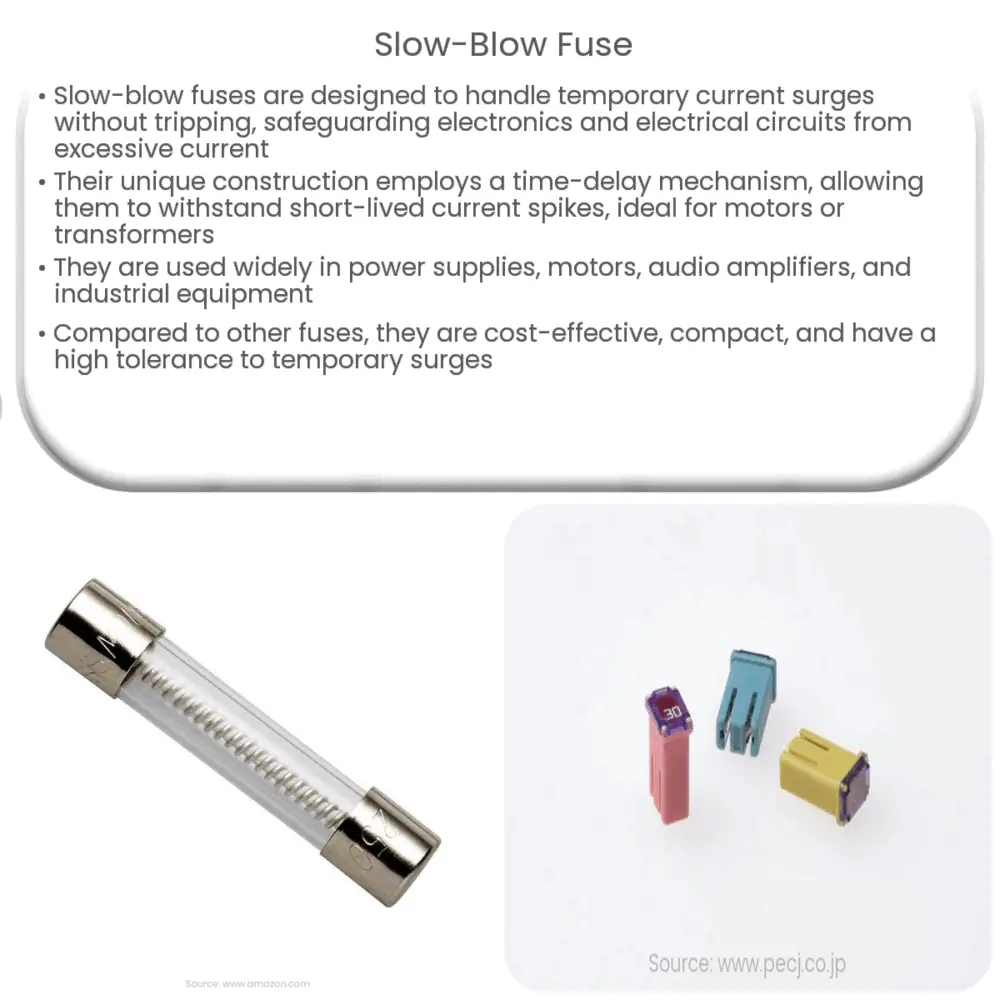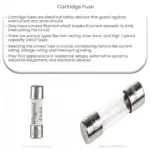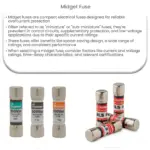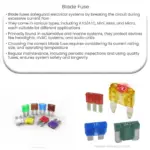A slow-blow fuse is a safety device designed to handle temporary current surges, protecting sensitive electronics from damage due to excessive current.

Understanding Slow-Blow Fuses: Protection for Your Electronics
Introduction to Slow-Blow Fuses
A slow-blow fuse is a specialized type of fuse designed to handle temporary current surges without tripping. These fuses are commonly used in electronics and electrical circuits to protect sensitive components from damage caused by excessive current. In this article, we will discuss the working principle of slow-blow fuses, their applications, and advantages over other types of fuses.
Working Principle of Slow-Blow Fuses
Like any other fuse, a slow-blow fuse is essentially a safety device that interrupts an electrical circuit when excessive current flows through it. However, slow-blow fuses have a unique construction that allows them to withstand short-term current surges without breaking the circuit. This is achieved by employing a time-delay mechanism in the fuse design. The fuse contains a metal wire or strip that is specifically designed to melt and break the circuit when exposed to high current for an extended period.
The key difference between slow-blow and fast-acting fuses is their response time to current overloads. While a fast-acting fuse responds almost instantly to an overload, a slow-blow fuse allows a temporary surge to pass through before tripping. This characteristic is particularly useful in protecting electronic devices and circuits that experience regular, short-lived current spikes during normal operation, such as motors or transformers.
Applications of Slow-Blow Fuses
Slow-blow fuses are suitable for a wide range of applications in various industries, including consumer electronics, automotive systems, and industrial equipment. Some common applications include:
- Power Supplies: Slow-blow fuses are used in power supplies to protect against short circuits and overloads that may result from component failures or voltage fluctuations.
- Motor Protection: Motors can experience temporary current surges during start-up or under heavy load conditions. A slow-blow fuse can handle these surges without tripping, providing adequate protection to the motor and its control circuitry.
- Audio Amplifiers: In audio systems, slow-blow fuses protect amplifiers from damage caused by speaker shorts or other faults that could lead to excessive current draw.
- Industrial Equipment: Slow-blow fuses are employed in various industrial machines and control systems, safeguarding them from overloads and short circuits that may occur during operation.
Advantages of Slow-Blow Fuses
Slow-blow fuses offer several advantages over other types of fuses, such as fast-acting or semiconductor fuses. These benefits include:
- Tolerance to Temporary Surges: As mentioned earlier, slow-blow fuses can withstand short-term current surges without tripping. This makes them suitable for protecting devices and circuits that experience normal current spikes during operation.
- Compact Size: Slow-blow fuses are available in a variety of compact form factors, making them suitable for use in space-constrained applications.
- Cost-Effective: Compared to other types of fuses, slow-blow fuses are relatively inexpensive and easy to replace, reducing maintenance costs and downtime.
Selection Criteria for Slow-Blow Fuses
Choosing the right slow-blow fuse for your application requires careful consideration of several factors, including:
- Current Rating: Select a fuse with a current rating slightly higher than the normal operating current of the device or circuit it is protecting. This ensures that the fuse does not trip during normal operation, while still providing adequate protection against overloads.
- Voltage Rating: The voltage rating of the fuse should be equal to or greater than the maximum voltage the circuit may be exposed to. A fuse with a lower voltage rating may not provide adequate protection and may even pose a safety risk.
- Breaking Capacity: The breaking capacity of a fuse indicates the maximum fault current it can safely interrupt. Choose a fuse with a breaking capacity that meets or exceeds the maximum possible fault current in your application.
- Physical Size and Mounting Style: Ensure the selected fuse fits the available space and is compatible with the mounting style of your device or circuit. Common mounting styles include PCB mount, panel mount, and cartridge fuses.
Maintenance and Replacement of Slow-Blow Fuses
Like all fuses, slow-blow fuses have a limited lifespan and may need to be replaced periodically. To maintain the reliability and safety of your devices and circuits, follow these guidelines:
- Regular Inspection: Inspect fuses regularly for signs of wear, discoloration, or damage. Replace any fuse that appears compromised or has exceeded its recommended service life.
- Proper Replacement: When replacing a slow-blow fuse, ensure the new fuse has the same current, voltage, and breaking capacity ratings as the original. Using an incorrect fuse can result in inadequate protection or even damage to your equipment.
- Address Underlying Issues: If a slow-blow fuse trips or fails, investigate the cause of the overload or short circuit before replacing the fuse. Simply replacing the fuse without addressing the underlying issue may lead to repeated failures and potential damage to your equipment.
Conclusion
Slow-blow fuses are essential components for protecting sensitive electronics and electrical circuits from damage caused by excessive current. Their ability to tolerate short-term current surges makes them ideal for a wide range of applications, from consumer electronics to industrial machinery. By understanding the working principle, applications, and advantages of slow-blow fuses, you can make informed decisions when selecting and maintaining these crucial safety devices.




